Sustainable Spring Water Extraction—A Remedy to Water Shortage?
Abstract
1. Introduction
2. Materials and Methods
2.1. Study Area
2.2. Field Research
3. Results
4. Discussion
5. Conclusions
- Spatial variability: Western catchments, draining Cretaceous carbonate aquifers, showed the highest sustainable extraction potential. Eastern catchments, despite their high theoretical capacity, were limited by low yields and unstable discharge.
- Significant volume: Sustainable extraction across the region could supply daily water for approximately 881,500 people (≈75% of the regional population), with the Giełczew catchment alone capable of supporting over 180,000 individuals.
- Methodology: The Q90-based TLM offers a low-data, transferable, and precautionary tool aligned with environmental flow protection and sustainability principles.
Author Contributions
Funding
Institutional Review Board Statement
Informed Consent Statement
Data Availability Statement
Conflicts of Interest
References
- Li, R. Assessing Groundwater Pollution Risk in Response to Climate Change and Variability. In Emerging Issues in Groundwater Resources; Fares, A., Ed.; Springer: Cham, Switzerland, 2016; pp. 31–50. [Google Scholar]
- Li, Y.; Fu, Q.; Li, T.; Liu, D.; Hou, R.; Li, Q.; Yi, J.; Li, M.; Meng, F. Snow melting water infiltration mechanism of farmland freezing-thawing soil and determination of meltwater infiltration parameter in seasonal frozen soil areas. Agric. Water Manag. 2021, 258, 107165. [Google Scholar] [CrossRef]
- Twinomucunguzi, F.R.B.; Nyenje, P.M.; Kulabako, R.N.; Semiyaga, S.; Foppen, J.W.; Kansiime, F. Emerging Organic Contaminants in Shallow Groundwater Underlying Two Contrasting Peri-Urban Areas in Uganda. Environ. Monit. Assess. 2021, 193, 228. [Google Scholar] [CrossRef] [PubMed]
- De Graf, I.E.M.; Stahl, K. A Model Comparison Assessing the Importance of Lateral Groundwater Flows at the Global Scale. Environ. Res. Lett. 2022, 17, 044020. Available online: https://iopscience.iop.org/article/10.1088/1748-9326/ac50d2 (accessed on 30 November 2021). [CrossRef]
- Swain, S.; Taloor, A.K.; Dhal, L.; Sahoo, S.; Al-Ansari, N. Impact of climate change on groundwater hydrology: A comprehensive review and current status of the Indian hydrogeology. Appl. Water Sci. 2022, 12, 120. [Google Scholar] [CrossRef]
- Kumar, D.; Singh, A.K.; Taloor, A.K.; Singh, D.S. Recessional Pattern of Thelu and Swetvarn Glaciers Between 1968 and 2019, Bhagirathi Basin, Garhwal Himalaya, India. Quat. Int. 2021, 575–576, 227–235. [Google Scholar] [CrossRef]
- Talabi, A.; Abdu-Raheem, Y.; Afolagboye, L.; Oguntuase, M.; Akinola, O. Hydrogeochemistry of shallow groundwater in Ado-Ekiti Area, Southwestern Nigeria. Groundw. Sustain. Dev. 2020, 11, 100386. [Google Scholar] [CrossRef]
- Oberhauser, D.; Hägele, R.; Dombrowsky, I. Unravelling hidden factors explaining competition for and overuse of groundwater in Azraq, Jordan: Digging deeper into a network of action situations. Sustain. Sci. 2023, 18, 235–249. [Google Scholar] [CrossRef]
- Rehrl, C.; Birk, S. Hydrogeological Characterisation and Modelling of Spring Catchments in a Changing Environment. Austrian J. Earth Sci. 2010, 103, 106–117. [Google Scholar]
- Kumar, M.; Rathod, R.; Mukherji, A. Water Security and Spring Conservation in the Himalaya. In Climate Risks to Water Security: Framing Effective Response in Asia and the Pacific; Palgrave Macmillan: London, UK, 2023; pp. 15–36. [Google Scholar]
- Caldwell, T.G.; Wolaver, B.D.; Bongiovanni, T.; Pierre, J.P.; Robertson, S.; Abolt, C.; Scanlon, B.R. Spring Discharge and Thermal Regime of a Groundwater Dependent Ecosystem in an Arid Karst Environment. J. Hydrol. 2020, 587, 124947. [Google Scholar] [CrossRef]
- Lu, M.; Rogiers, B.; Beerten, K.; Gedeon, M.; Huysmans, M. Exploring River–Aquifer Interactions and Hydrological System Response Using Baseflow Separation, Impulse Response Modeling, and Time Series Analysis in Three Temperate Lowland Catchments. Hydrol. Earth Syst. Sci. 2022, 26, 3629–3649. [Google Scholar] [CrossRef]
- Taloor, A.K.; Pir, R.A.; Adimalla, N.; Ali, S.; Manhas, D.S.; Roy, S.; Singh, A.K. Spring Water Quality and Discharge Assessment in the Basantar Watershed of Jammu Himalaya Using Geographic Information System (GIS) and Water Quality Index (WQI). Groundw. Sustain. Dev. 2020, 10, 100364. [Google Scholar] [CrossRef]
- Chhimwal, M.; Kaur, S.; Srivastava, R.K.; Hagare, D.; Shiva Prasad, H.J. Water Quality of Springs and Lakes in the Kumaon Lesser Himalayan Region of Uttarakhand, India. J. Water Health 2022, 20, 737–754. [Google Scholar] [CrossRef] [PubMed]
- Ferencz, B.; Dawidek, J.; Bronowicka-Mielniczuk, U. Alteration of Yield and Springs Number as an Indicator of Climate Changes. Case Study of Eastern Poland. Ecol. Indic. 2022, 138, 108798. [Google Scholar] [CrossRef]
- Gawrysiak, L.; Baran-Zgłobicka, B.; Zgłobicki, W. Flash Floods Hazard to the Settlement Network versus Land Use Planning (Lublin Upland, East Poland). Appl. Sci. 2024, 14, 8425. [Google Scholar] [CrossRef]
- Krogulec, E.; Gurwin, J.; Wąsik, M. Cost of groundwater protection: Major groundwater basin protection zones in Poland. Int. Environ. Agreem. Politics Law Econ. 2021, 21, 517–530. [Google Scholar] [CrossRef]
- Dragon, K. Identification of Groundwater Conditions in the Recharge Zone of Regionally Extended Aquifer System with Use of Water Chemistry and Isotopes (Lwowek Region, Poland). J. Hydrol. Reg. Stud. 2021, 34, 100787. [Google Scholar] [CrossRef]
- Virkki, V.; Kummu, M.; Wang-Erlandsson, L.; Porkka, M.; Varis, O. Widespread Increasing Violations of Environmental Flow Envelopes. Earth Syst. Sci. 2022, 26, 3315–3331. [Google Scholar] [CrossRef]
- Berthot, N.; St-Hilaire, A.; Daigle, A.; Gauthier, Y. Environmental Flow Assessment in the Context of Climate Change: A Case Study in Southern Quebec, Canada. J. Water Clim. Change 2021, 12, 3617–3634. [Google Scholar] [CrossRef]
- Grabowski, T.; Jóźwiakowski, K.; Bochniak, A.; Micek, A. Changes in the Amount of Rainwater in the Roztocze National Park (Poland) in 2001–2020 and the Possibility of Using Rainwater in the Context of Ongoing Climate Variability. Water 2022, 14, 1334. [Google Scholar] [CrossRef]
- Zgłobicki, W.; Kukiełka, S.; Baran-Zgłobicka, B. Regional Geotourist Resources—Assessment and Management (A Case Study in SE Poland). Resources 2020, 9, 18. [Google Scholar] [CrossRef]
- Margielewski, W.; Jankowski, L.; Krąpiec, M.; Garecka, M.; Hałas, S.; Urban, J. Analysis of Reworked Sediments as a Basis of the Palaeogene-Neogene Palaeogeography Reinterpretation: Case Study of the Roztocze Region (SE Poland). Sediment. Geol. 2017, 352, 14–29. [Google Scholar] [CrossRef]
- Zieliński, M.; Dopieralska, J.; Królikowska-Ciągło, S.; Walcz, A.; Belka, Z. Mapping Spatial Variability of Sr Isotope Signatures (87Sr/86Sr) in Poland—Implications for Anthropogenic Sr Contamination in Archaeological Provenance and Migration Research. Sci. Total Environ. 2021, 775, 145792. [Google Scholar] [CrossRef]
- Raczyński, K.; Dyer, J. Development of an Objective Low Flow Identification Method Using Breakpoint Analysis. Water 2022, 14, 2212. [Google Scholar] [CrossRef]
- Cinkus, G.; Maz, N.; Jourde, H.; Wunsch, A.; Liesch, T.; Ravbar, N.; Chen, Z.; Goldscheider, N. Comparison of artificial neural networks and reservoir models for simulating karst spring discharge on five test sites in the Alpine and Mediterranean regions. Hydrol. Earth Syst. Sci. 2023, 27, 2397–2411. [Google Scholar] [CrossRef]
- Leonowicz, A. Two-Variable Choropleth Maps: A Useful Tool for Visualizing Geography. Geografija 2006, 42, 33–37. Available online: https://mokslozurnalai.lmaleidykla.lt/publ/1392-1096/2006/1/Geog_033_037_spalvotas.pdf (accessed on 15 April 2023).
- Hasan, N.; Pushpalatha, R.; Manivasagam, V.; Arlikatti, S.; Cibin, R. Global Sustainable Water Management: A Systematic Qualitative Review. Water Resour. Manag. 2023, 37, 5255–5272. [Google Scholar] [CrossRef]
- Scanlon, B.R.; Richey, A.S.; Wada, Y.; Reedy, R.C. Global Water Resources and the Role of Groundwater in a Resilient Water Future. Nat. Rev. Earth Environ. 2023, 4, 87–101. [Google Scholar] [CrossRef]
- Yang, J.; Wada, Y.; Wander, N.; Bierkens, M.F.P. Incorporating Groundwater Representation in a Large-Scale Hydrological Model: A Case Study of the Rhine-Meuse Basin. Hydrol. Earth Syst. Sci. 2017, 21, 4687–4704. [Google Scholar]
- Jakada, H.; Chen, Z.; Luo, M.; Zhou, H.; Wang, Z.; Habib, M. Watershed Characterization and Hydrograph Recession Analysis: A Comparative Look at Karst vs. Non-Karst Watershed Implications for Groundwater Resources in the Gaolan River Basin, South China. Water 2021, 11, 743. [Google Scholar] [CrossRef]
- Ghimire, U.; Shrestha, S.; Neupane, S.; Mohanasundaram, S.; Lorphensri, O. Climate and land-use change impacts on spatiotemporal variations in groundwater recharge: A case study of the Bangkok Area, Thailand. Sci. Total. Environ. 2021, 792, 148370. [Google Scholar] [CrossRef]
- Abirifard, M.; Birk, S.; Raeisi, E.; Sauter, M. Dynamic volume in karst aquifers: Parameters affecting the accuracy of estimates from recession analysis. J. Hydrol. 2022, 612, 128286. [Google Scholar] [CrossRef]
- Saito, L.; Christ, B.; Diffley, J.; Richter, H.; Rohde, M.M.; Morrison, S.A. Managing Groundwater to Ensure Ecosystem Function. Ground Water 2021, 59, 322–333. [Google Scholar] [CrossRef] [PubMed]
- Michalczyk, Z.; Chmiel, S.; Głowacki, S.; Sposób, J.; Zielińska, B. Changes in Discharge and Physico-Chemical Properties of Spring Water in Pliszczyn Near Lublin. Biul. Państw. Inst. Geol. 2019, 476, 87–94. [Google Scholar]
- Buczyński, S. Temporal Variability of Springs in Catchment Areas Located in the Sudetes Mountains. Hydrol. Res. 2017, 49, 780–793. [Google Scholar] [CrossRef]
- Keegan-Treloar, R.; Irvine, D.J.; Solórzano-Rivas, S.C.; Werner, A.D.; Banks, E.W.; Currell, M.J. Fault-controlled springs: A review. Earth-Sci. Rev. 2022, 230, 104058. [Google Scholar] [CrossRef]
- Dobrowolski, A.; Harasimiuk, M.; Brzezińska-Wójcik, T. Structural Control of Relief in the Lublin Upland Roztocze Region. Prz. Geol. 2014, 62, 51–56. [Google Scholar]
- Kraj, S.; Woźnicka, M. Hydrogeological Structure of the Vistula River Valley Between Kamień and Puławy, East Poland. Geol. Quat. 2003, 47, 77–82. [Google Scholar]
- Chabudziński, Ł.; Brzezińska-Wójcik, T. Zastosowanie ArcNEO do Oceny Przejawów Neotektoniki na Przykładzie Zlewni Górnego Wieprza (Roztocze, Środkowo-Wschodnia Polska). Landf. Anal. 2013, 24, 11–22. [Google Scholar] [CrossRef]
- Chabudziński, Ł.; Brzezińska-Wójcik, T. Spatial Relationship Between the Distribution of Springs with High Discharge and Neotectonics in the Biała Łada Catchment, Goraj, Roztocze Region (Central-Eastern Poland). Prz. Geol. 2017, 65, 1184–1188. [Google Scholar]
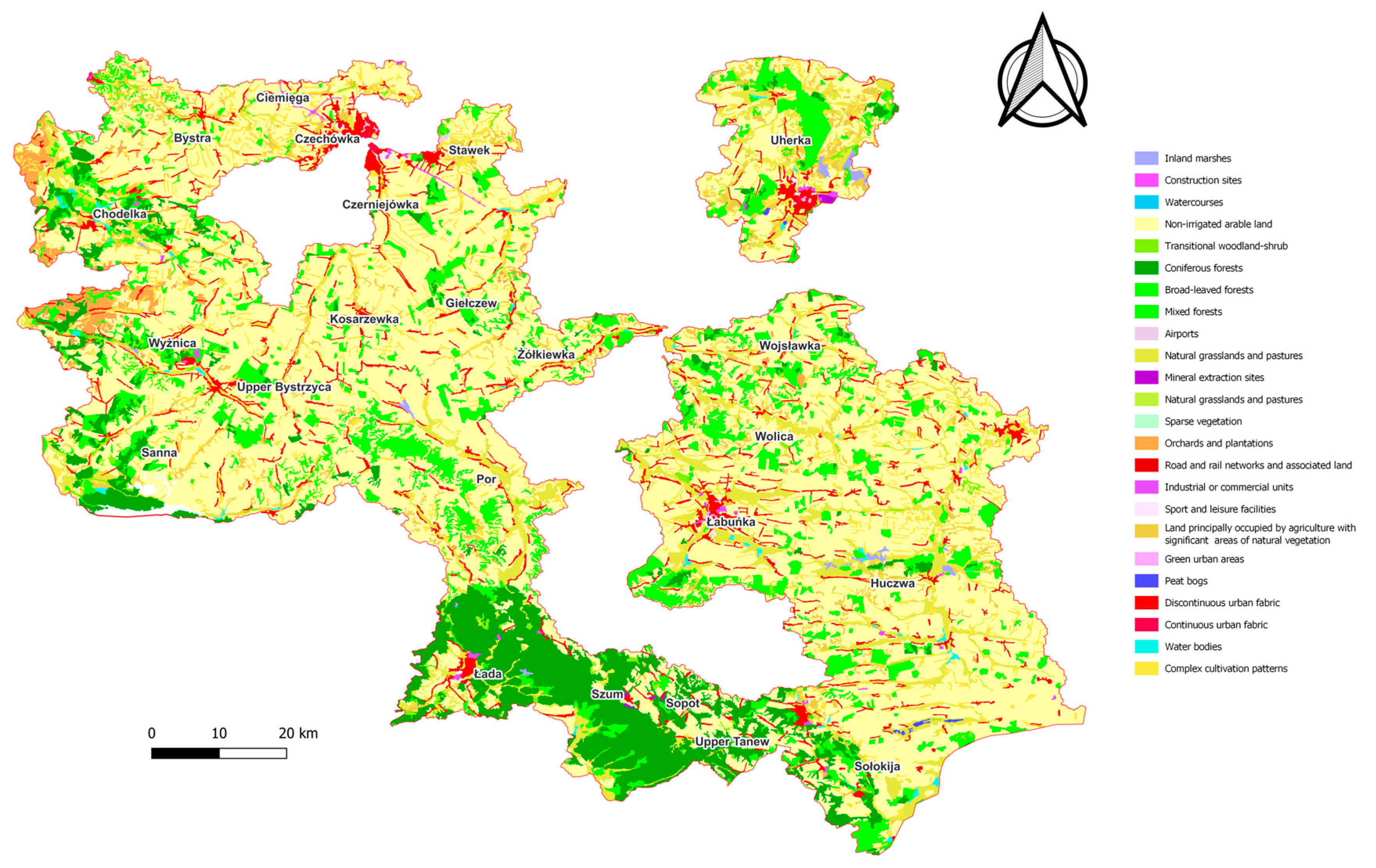
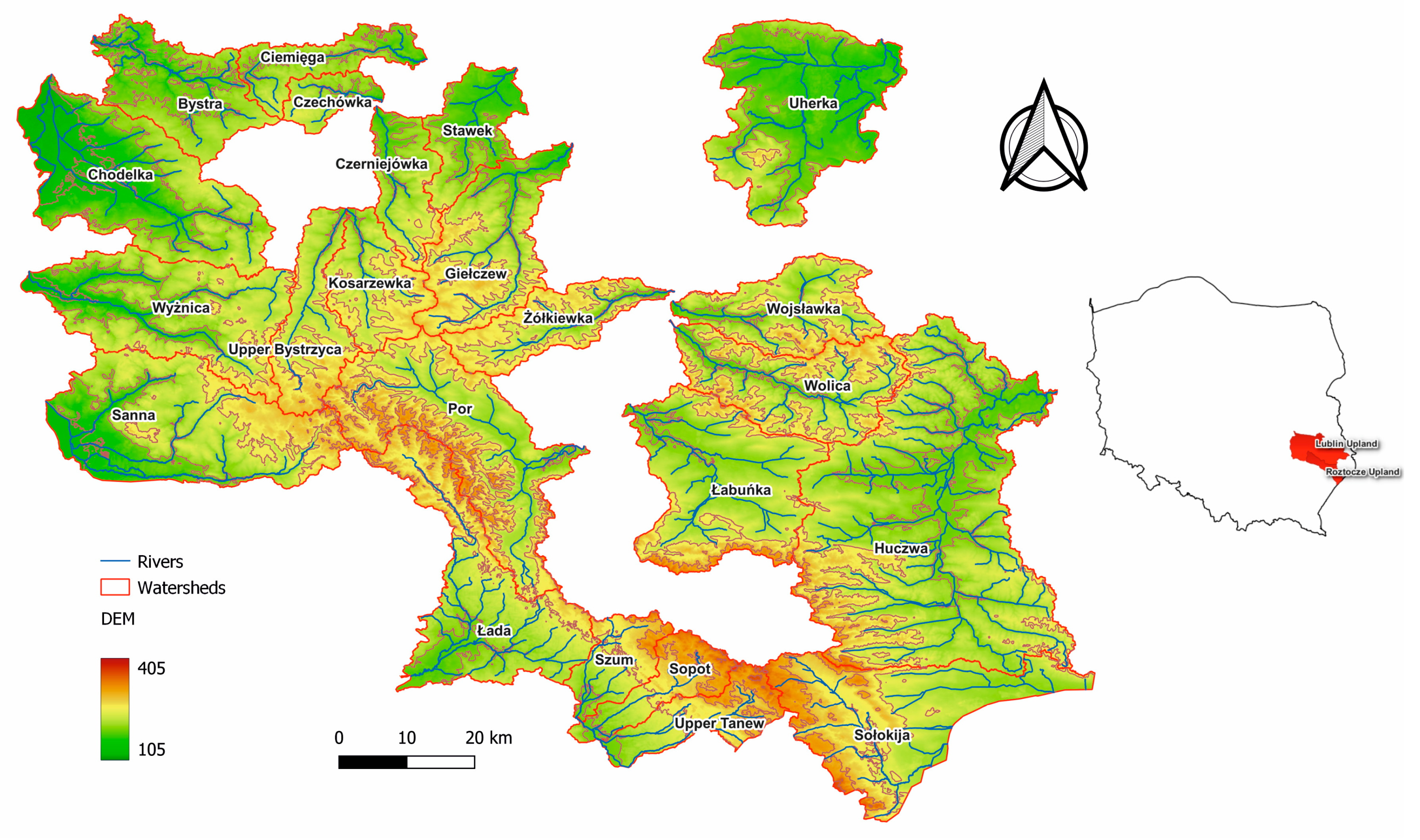



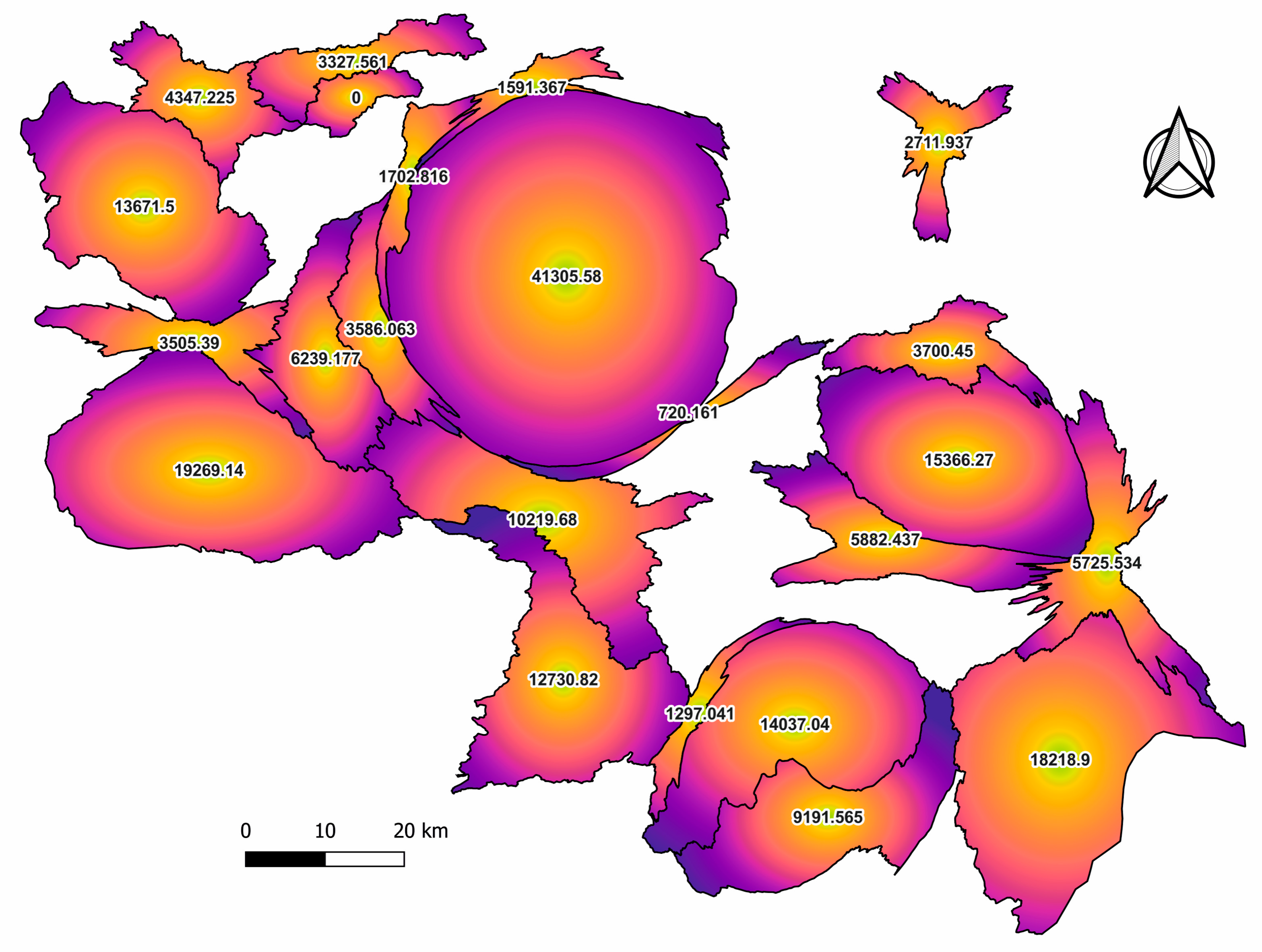
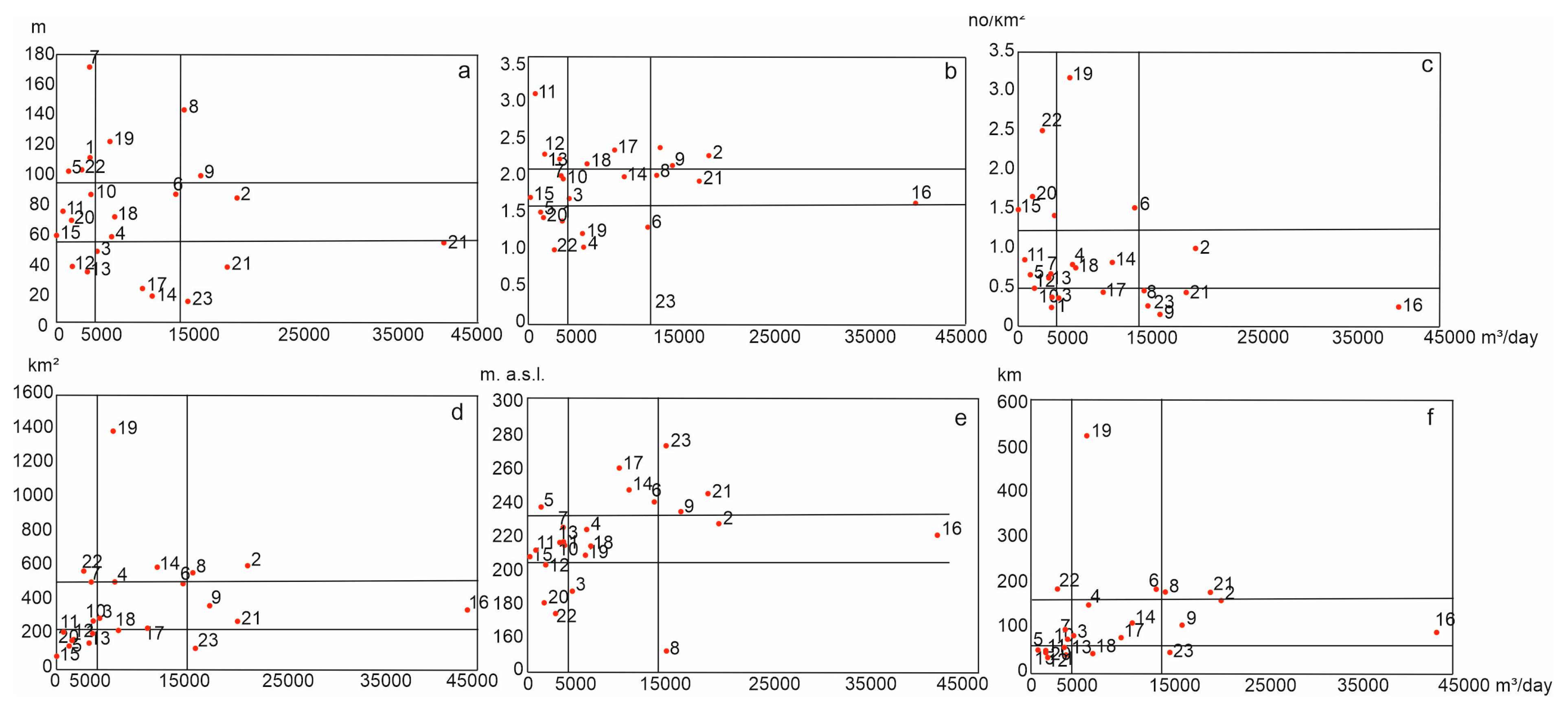
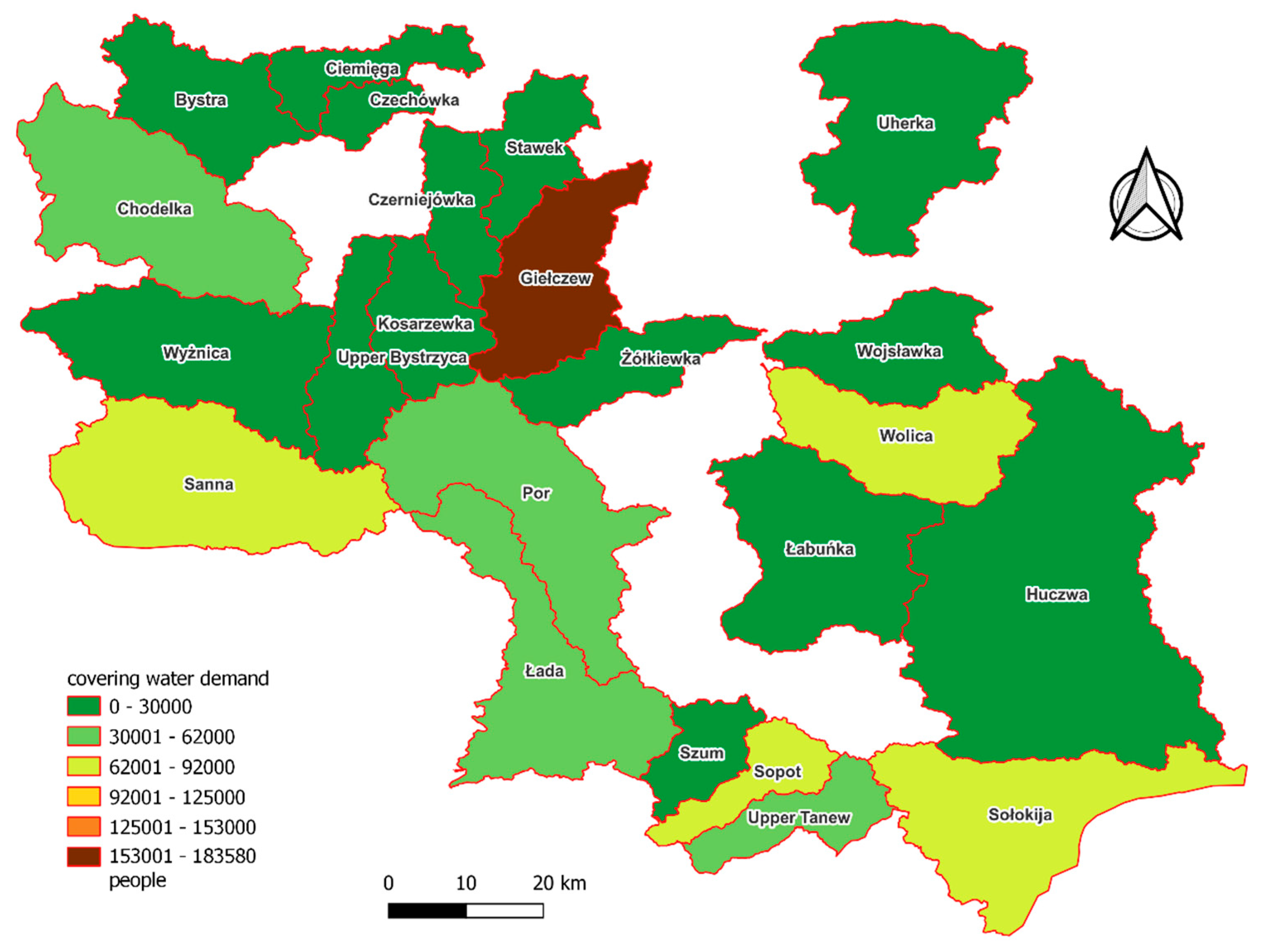

Disclaimer/Publisher’s Note: The statements, opinions and data contained in all publications are solely those of the individual author(s) and contributor(s) and not of MDPI and/or the editor(s). MDPI and/or the editor(s) disclaim responsibility for any injury to people or property resulting from any ideas, methods, instructions or products referred to in the content. |
© 2025 by the authors. Licensee MDPI, Basel, Switzerland. This article is an open access article distributed under the terms and conditions of the Creative Commons Attribution (CC BY) license (https://creativecommons.org/licenses/by/4.0/).
Share and Cite
Ferencz, B.; Dawidek, J. Sustainable Spring Water Extraction—A Remedy to Water Shortage? Sustainability 2025, 17, 5798. https://doi.org/10.3390/su17135798
Ferencz B, Dawidek J. Sustainable Spring Water Extraction—A Remedy to Water Shortage? Sustainability. 2025; 17(13):5798. https://doi.org/10.3390/su17135798
Chicago/Turabian StyleFerencz, Beata, and Jarosław Dawidek. 2025. "Sustainable Spring Water Extraction—A Remedy to Water Shortage?" Sustainability 17, no. 13: 5798. https://doi.org/10.3390/su17135798
APA StyleFerencz, B., & Dawidek, J. (2025). Sustainable Spring Water Extraction—A Remedy to Water Shortage? Sustainability, 17(13), 5798. https://doi.org/10.3390/su17135798







